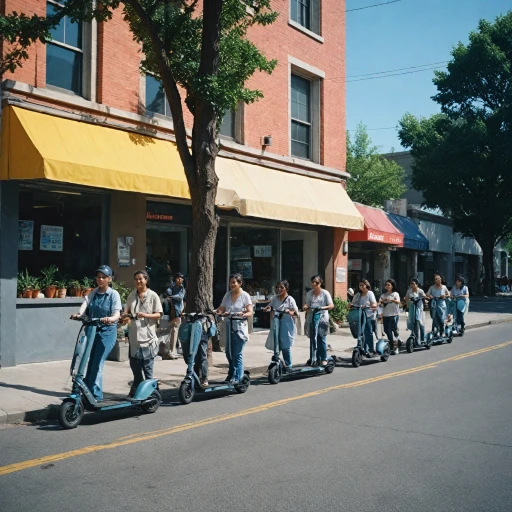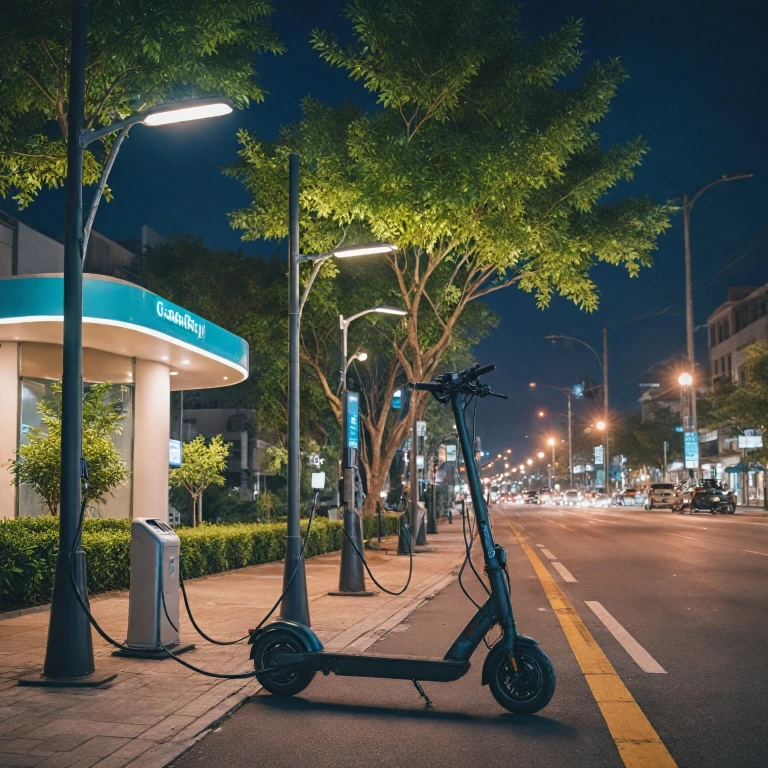How Electric Scooter Batteries Work
Decoding the Mechanics of Scooter Power
Understanding how electric scooter batteries function is crucial in managing their efficiency and longevity. Electric scooters predominantly rely on lithium-ion batteries due to their high energy density, which means they can store more power in a compact space, allowing for longer rides compared to lead-acid alternatives.
Lithium-ion batteries operate by shuttling ions between the positive and negative electrodes through an electrolyte, generating power that propels your scooter. This journey allows the scooter to function for a set number of hours before needing a recharge. The battery's capacity, typically measured in amp-hours (Ah), determines how long the scooter will provide power and, consequently, how far you can ride before requiring another charge.
However, while the allure of seamless power may seem straightforward, many factors influence your battery's performance. A fundamental understanding of these components will aid not just in effective scooter charging but also in preventing common battery-related issues. Moreover, maintaining optimal battery health extends your scooter's lifespan and maximizes your investment.
To dig deeper into battery chargers and their functions, exploring sources that detail
the essentials of e-scooter battery chargers can provide further enlightenment, ensuring you're well-equipped to tackle charging challenges efficiently.
Charging Your Electric Scooter: Step-by-Step Guide
Step-by-Step Charging Guide for Electric Scooters
Charging your electric scooter may seem like a straightforward process, but following a systematic approach ensures accuracy and efficiency. Here’s how to charge your electric scooter effectively:
- Find the Right Charger and Port
- Always use a compatible charger with the correct voltage and wattage for your scooter battery. Using an unsuitable charger can lead to charging failures or even damage to your scooter battery.
- Locate the charging port on your scooter, which is typically found near the footboard or under the seat.
- Charging in Optimal Conditions
- Ensure your electric scooter is turned off before you start charging to prevent any electrical issues.
- Place the scooter in a stable and dry location, away from direct sunlight or rain. Moisture can affect the charging process and battery life.
- Plug-in Sequence
- Connect the charger to the charging port on the scooter before plugging it into the power outlet. This helps avoid any short circuits that could occur with live power connections.
- Monitoring the Charging Process
- Keep an eye on the charging indicator light. Most chargers have LED lights that show whether the scooter is charging or fully charged. This provides a clear signal to monitor the progress.
- Be patient as lithium ion batteries take time to reach a full charge. Most scooters typically take about 3 to 5 hours, depending on the battery capacity.
- Unplugging Safely
- Once fully charged, unplug the charger from the power outlet first, and then from the scooter. This reduces the risk of electrical surges.
- Check Battery Capacity after Charging
- It's helpful to periodically check the battery status, especially if you are planning a long ride. This ensures that your scooter battery will deliver the expected power and mileage.
- Understanding the Use of Proper Chargers
- Learn more about the importance of chargers with a special focus on essential insights for electric scooter enthusiasts which can provide more tailored advice for your specific model and needs.
Common Charging Mistakes to Avoid
Charging Errors You Should Be Aware Of
Charging your electric scooter might seem straightforward, but there are several common mistakes that can lead to issues such as decreased battery life and performance. Avoid these pitfalls to ensure your scooter remains in optimal condition.
- Improper Charger Use: Always make sure to use the correct charger for your scooter. Each model has specific charger and battery specifications; using the wrong one could result in charging inefficiencies or even damage. Incorrect pairing can strain your scooter's battery and significantly reduce its lifespan.
- Ignoring Charging Port Care: The charging port is often overlooked, but it's essential to keep it clean and free from debris. Dirt or moisture can interfere with the charging process, potentially causing damage or slowing the charge rate. A simple habit of checking the port regularly helps avoid future issues.
- Overcharging the Battery: For lithium-ion batteries, overcharging can be harmful. Once your electric scooter is fully charged, disconnect the charger to maintain battery capacity and health. Some chargers have an automatic shut-off feature, but it's wise to double-check that this function is active.
- Charging Right After a Ride: Batteries heat up after use, and charging immediately after a ride can increase the wear on the battery. Allow the battery to cool down for at least 30 minutes before plugging it in for a charge.
- Partial Charges: Although partial charging isn't as damaging as overcharging, it can still impact the number of full charge cycles your battery can handle. To extend battery life, it's best to regularly allow your electric scooter to charge fully, without interruption.
Understanding and avoiding these common charging mistakes will not only enhance the performance of your electric scooter but will also save you from unnecessary scooter charging costs over time. If you need reliable services for your scooter, finding reliable electric scooter tire repair services nearby could also ensure your ride is always ready to go.
Tips for Increasing Battery Longevity and Efficiency
Maximizing the battery life and performance of your electric scooter is crucial to ensure you get the most out of your ride. Here are several practical tips to help you extend the battery life and maintain peak performance:
- Regularly Check Battery Levels: Monitoring your battery levels can prevent deep discharges that can severely damage lithium ion batteries. Make it a habit to plug the charger before hitting critical low levels.
- Charge Wisely: Aim to keep the battery level between 20% and 80% rather than constantly charging it to 100%. This helps in prolonging the battery capacity and reduces stress on the battery cells.
- Avoid Extreme Temperatures: Both high and low temperatures can affect battery performance. Try to charge and store your electric scooter in a cool, dry place.
- Opt for Regular, Shorter Charges: Instead of long charging periods, frequent shorter charges can help maintain good battery health, especially for lithium batteries, which can degrade if left to fully deplete.
- Use the Correct Charger: Ensure you are using the right battery charger specified by the manufacturer. Using incompatible chargers can lead to charging inefficiencies and possible damage.
- Don’t Forget Maintenance: Regular maintenance checks on connections and the battery charging port can prevent potential issues that might arise during charging.
Understanding these practices not only enhances the battery life of your electric scooter but also ensures that you can count on it every time you're ready to ride. While initial charging costs may seem minimal, these practices can help mitigate future expenses associated with replacing worn-out batteries.
Safety Precautions During Charging
Ensuring Safety While Charging
Charging your electric scooter may seem like a straightforward task, but following the right safety measures can ensure your scooter and its battery maintain optimal performance. Here’s how you can make sure you’re charging safely:
- Use the Correct Charger: Each electric scooter model comes with a recommended charger. Using the wrong battery charger can lead to overcharging or undercharging, which can damage the battery. Always opt for the charger that matches your scooter’s battery capacity and specifications.
- Check the Charging Port: Prior to charging, inspect the charging port for any debris or damages. A clean and undamaged port ensures efficient charging. Keep the port covered when not in use to prevent dust and water from getting in.
- Avoid Water Contact: Lithium-ion batteries, though robust, can be sensitive to water. Always charge your electric scooters in a dry environment to prevent the charger or battery from coming into contact with moisture.
- Mind the Temperature: Charging your scooter under extreme temperatures, whether too hot or too cold, can affect the battery life and performance. It is best to charge the scooter at room temperature for safe and efficient power restoration.
- Monitor the Charging Process: While it’s not necessary to keep an eye on your scooter throughout the charging process, it is a good practice to periodically check on it. A fully charged battery should not be left plugged in for extended hours, as this could reduce its lifespan.
- Unplug After Fully Charged: Consistently leaving the charger in after the scooter is fully charged could lead to overheating. To maximize battery life, ensure you unplug the charger promptly once you reach full capacity.
Safety precautions during charging are crucial not only for the longevity of your scooter’s battery but also for ensuring safe rides each time. By following these practices, you’ll help prevent potential issues and maintain optimal performance from your scooter over time.
Understanding Charging Times and Costs
Estimating Charging Durations and Expenses
Understanding how long it takes to charge your electric scooter and the associated costs can be pivotal for efficient usage. Here’s a breakdown of what you need to know:
- Battery Capacity and Its Impact: The time required to charge your scooter's battery largely depends on its capacity, measured in amp hours (Ah). Larger batteries, typically found in e-scooters with extended ranges, will naturally take longer to become fully charged compared to those with smaller capacities.
- Charger Output: Check the voltage and amperage output of your battery charger. A higher output can reduce the charging time. Always match the charger's power rating with your scooter battery’s specification to avoid any damage.
- Charging Times: On average, lithium-ion batteries, widely used in electric scooters, may take anywhere from 3 to 8 hours to reach a full charge. Lead acid batteries, though less common now, could require more time. Always refer to your scooter’s manual for specific guidance on charging times.
- Calculating Charging Costs: You can estimate the cost of charging your scooter by understanding the kilowatt-hours (kWh) consumed. Check your electric rate per kWh and multiply it with the electricity used in charging your scooter battery to get an approximate cost. Keep in mind that frequent charging will add to your monthly electricity bill.
- Factors Influencing Charging Times: Variables like the initial charge level, battery health, and even ambient temperature can influence how fast an e-scooter charges. Ensure your charging environment is optimal – neither too hot nor too cold – to maintain battery health and efficiency.
By considering these aspects, you can effectively manage your electric scooter charging routine, ensuring both time efficiency and cost-effectiveness. This not only maximizes your ride time but also extends the lifespan of your scooter battery.

